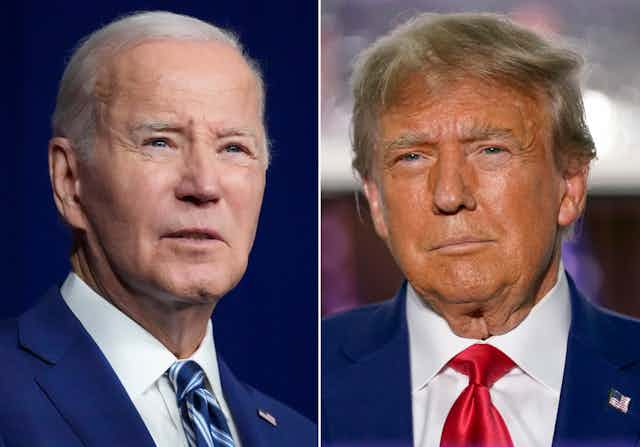The United States general election will be held on November 5 2024. In early 2024, there are Democratic and Republican presidential nominating contests that will elect delegates to the parties’ nominating conventions. These conventions, in July (for Republicans) and August (Democrats) officially select their parties’ presidential candidates.
The first contest is the Iowa Republican caucus on January 15, followed by the New Hampshire primary for both parties on January 23. There are several other contests in February before many states vote on “Super Tuesday”, March 5. The early contests account for a low percentage of total delegates, with under 10% of delegates determined by the Michigan primary on February 27.
A “caucus” is managed by the state party, and often requires voters to gather at a particular time. A “primary” is managed by the state’s electoral authority, and is administered in the same way as a general election. Turnout at primaries is much higher than at caucuses. In 2024, the large majority of contests use primaries.
Democratic delegates are allocated proportionally with a 15% threshold. Republican delegate allocation depends on the state: some states allocate delegates proportionally, but many others allocate delegates winner takes all or winner takes most.
In FiveThirtyEight polling aggregates, former president Donald Trump is way ahead in national Republican primary polls with 61.7%, followed by Ron DeSantis at 12.2% and Nikki Haley at 11.3%. Trump is also dominant in Iowa with 46.7%, followed by DeSantis at 19.6% and Haley at 15.0%.
If the election results reflect these national polls, Trump will win a huge majority of delegates.
On the Democratic side, no prominent Democrat has challenged President Joe Biden. Biden has 65.8% nationally with Marianne Williamson on 7.6% and Dean Phillips on 5.4%.
Trump leads in general election polls
In the presidential general election, there are 538 electoral votes and it takes 270 to win. Electoral votes are assigned to states as the sum of their House seats (population based) and senators (always two), so the lowest-population states have three EVs. With two minor exceptions, states award their EVs as winner-takes-all.
Trump won the 2016 election despite losing the national popular vote by 2.1%. In 2020, Biden won the popular vote by 4.5% but only won the state that gave him over 270 EVs by 0.6%. It’s likely Trump will benefit again from the skew in the electoral votes.
Read more: US 2016 election final results: how Trump won
Biden’s FiveThirtyEight national ratings are 55.6% disapprove, 38.3% approve (net -17.3). His ratings have been sliding since March, when he was at net -7.3. Trump’s ratings are 52.3% unfavourable, 42.3% favourable (net -9.9). His ratings have improved since August when he was at -18.1.
Biden trails Trump by low- to mid-single digits in most national polls, and this doesn’t factor in the likely electoral vote skew. Trump’s margin over Biden increases slightly when third party candidates are included.
By the general election, Biden will be almost 82 and Trump 78. Early November Siena polls for The New York Times gave Trump four-to-ten-point leads in five of the six closest 2020 Biden-won states.
While Trump led overall by five points in the Siena polls, an unnamed generic Democrat led Trump by eight. In a similar exercise a year before the 2020 election, Biden led Trump by two and a generic Democrat led by three. This implies replacing Biden with a far younger Democrat would enhance their hopes of beating Trump.
Economic pessimism is helping Trump
In an early December national Wall Street Journal poll, two-thirds rated the economy poor or not good, and two-thirds said it had become worse in the past two years, during Biden’s tenure. Trump led Biden by 52–35 on best to handle the economy. By 53–23, voters thought Biden’s policies had hurt rather than helped them personally, while they thought Trump’s policies had helped by 49–37.
US headline and core inflation were about 2% annually before COVID, but the headline inflation peaked at 8.9% in June 2022. While inflation has dropped to 3.1% in November, voters still remember that goods and services used to be much cheaper.
Real (inflation-adjusted) wages were up 0.2% in hourly terms or 0.5% in weekly terms in November, and are up 0.8% and 0.5% respectively for the 12 months to November.
The personal savings rate was 3.8% in October. Prior to COVID, savings were over 5%, and they surged to record levels during the pandemic owing to stimulus payments and lack of spending opportunities. But the effects of inflation have eroded those gains.
The US jobs numbers have continued to be solid, with 199,000 jobs added in November and an unemployment rate of 3.7%. The employment population ratio – the percentage of eligible Americans employed – was 60.5% in November. It has nearly returned to where it was before the COVID pandemic began (61.1%).
Can Biden recover?
There are nearly 11 months left before the general election. Economic pessimism may be lifted if there are more months where real wages increase substantially, and this should help Biden if it occurs.
Trump faces four separate court trials over alleged election interference after the 2020 election federally and in Georgia, wrongful retention of classified documents after leaving office and hush money payments to a porn star.
Even if he is convicted, Trump can still run for president. But a conviction may hurt Trump’s standing in the polls. If Trump won, he could pardon himself of federal charges, but not of the Georgia election interference charges or the hush money charges (this is a New York state case).
So the biggest hopes of a Biden recovery are an improvement in economic sentiment before the election and a conviction for Trump. But Biden’s age isn’t going to improve.
Democratic chances of holding the presidency could improve if Biden withdrew and allowed Democrats to select a replacement. For this to happen, Biden would need to withdraw before the Democratic convention on August 19–22 2024.

